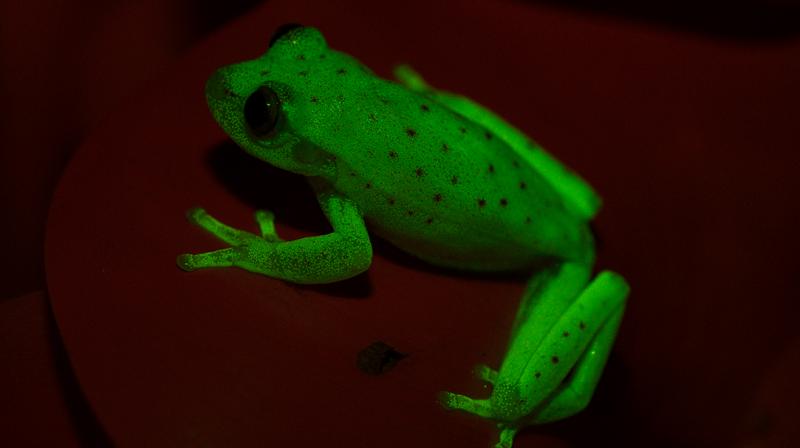World's first glow-in-the-dark frog discovered in Argentina
The fluorescent frog sports a muted palette of greens, yellows and reds in daylight, but gives off a bright blue and green glow in the dark.

Scientists have discovered the world's first fluorescent frog in Argentina that sports a muted palette of greens, yellows and reds under normal light, but gives off a bright blue and green glow in the dark. The ability to absorb light at short wavelengths and re-emit it at longer wavelengths is called fluorescence, and is rare in terrestrial animals. Until now, it was unheard of in amphibians.
Researchers found that the South American polka dot tree frog (Hypsiboas punctatus) uses fluorescent molecules totally unlike those found in other animals. Many ocean creatures exhibit fluorescence, including corals, fish, sharks and one species of sea turtle (the hawksbill turtle, Eretmochelys imbricata). On land, fluorescence was previously known in only parrots and some scorpions.
It is unclear why animals have this ability, although explanations include communication, camouflage and mate attraction, researchers said.
They expected to find red fluorescence in these frogs, because they contain a pigment called biliverdin. Normally, biliverdin turns the amphibian's tissues and bones green. However, in some insects, proteins bound to biliverdin emit a faint red fluorescence, said Carlos Taboada, from the University of Buenos Aires in Argentina.
However, in the polka dot tree frog, biliverdin turned out to be a red herring.
When researchers trained a ultraviolet A flashlight (or black light) on polka dot tree frogs collected near Santa Fe, Argentina, they were astonished to find the animals gave off an intense greenish-blue glow instead of a faint red.
Three molecules - hyloin-L1, hyloin-L2 and hyloin-G1 – in the animals' lymph tissue, skin and glandular secretions were responsible for the green fluorescence. The molecules contain a ring structure and a chain of hydrocarbons, and are unique among known fluorescent molecules in animals.
The closest similar molecules are found in plants, said Norberto Peporine Lopes, from the University of Sao Paulo in Brazil.
The newly described fluorescent molecules emit a surprising amount of light, providing about 18 per cent as much visible light as a full Moon - enough for a related species of frog to see by. Almost nothing is known about the polka dot tree frog's visual system or photoreceptors, so Taboada plans to study these to determine whether the frogs can see their own fluorescence.
The study was published in the journal Proceedings of the National Academy of Sciences.
